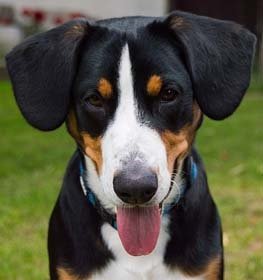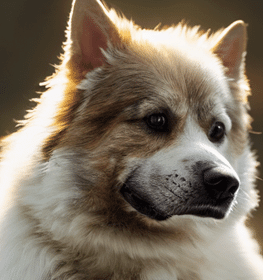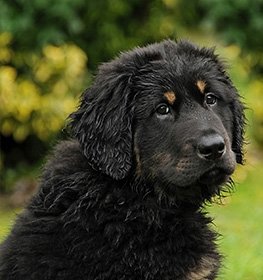Pyrenean Mastiff Information & Dog Breed Facts
Collection of all the general dog breed info about Pyrenean Mastiff so you can get to know the breed more.
| Group | Guard Dogs |
|---|---|
| Popularity Rank | 330 |
| Reviews | 0 |
| User Ratings | |
|
Compare the Pyrenean Mastiff With Other Dogs
Select at least one dog breed to make the comparsion. | |
 | |
| Origin | |
|
Common Names & Aliases
What other names is a Pyrenean Mastiff known by? Discover all traditional, regional and informal names used for this breed. | Mastin d'AragonMastín del PirineoMostín d'o PireneuPerro Mastin del Pireneo |
|---|---|
|
Breed Classification
What type of dog breed is a Pyrenean Mastiff? Learn about its genetic classification and breeding category. | Purebred |
|
Size Classification
What size category is a Pyrenean Mastiff? Learn how big the Pyrenean Mastiff breed typically grows. | Giant |
|---|---|
|
Weight Statistics
How much does a Pyrenean Mastiff weigh? Discover typical weight ranges for adult males and females of the Pyrenean Mastiff breed. | Male: 178-200 pounds (81-90 kg), Female: 200-220 pounds (90-100 kg) |
|
Average Weight
What is the average weight of a Pyrenean Mastiff? | Male: 190 pounds (85 kg), Female: 210 pounds (95 kg) |
|
Height
How tall is the Pyrenean Mastiff? Pyrenean Mastiff height: | Male: 29.5-31 inches (75-80 cm), Female: 26-28.5 inches (68-73 cm) |
|
Average Height
What is the average height of a Pyrenean Mastiff? | Male: 30 inches (77 cm), Female: 28 inches (71 cm) |
|
Price Range
How much does a Pyrenean Mastiff puppy cost? Find current market prices and factors affecting Pyrenean Mastiff costs. | $900-$1000 If you choose to purchase the Pyrenean Mastiff, you should know that the mentioned amount of money is an average of the collected data from breeders’ sites and puppy finder places. If you have a Pyrenean Mastiff for sale, please advertise it on a reliable website to make sure the Pyrenean Mastiff gets to a happy place. |
|---|---|
|
Availability
How easy is it to get a Pyrenean Mastiff? How many Pyrenean Mastiff are there in the world? | Average: The Pyrenean Mastiff is a commonly available dog breed. There is less risk of overbreeding compared to the very popular dogs. Of course, they may be more popular in some countries, and inbreeding may occur, so be careful. |
|
Intelligence Rating
How intelligent is a Pyrenean Mastiff? Discover the Pyrenean Mastiff's intelligence ranking and learning capabilities. | Very smart: Pyrenean Mastiff is an excellent dog breed. You can teach them many tricks and commands. The limit is your creativity. They understand and memorize new commands in 5-15 repetitions. This breed obeys the first command 85% of the time or better.
The Pyrenean Mastiff is one of the top breeds in the dog intelligence ranking. |
|---|---|
|
Training Difficulty
How easy is it to train a Pyrenean Mastiff? Learn about the Pyrenean Mastiff's trainability and response to training methods. | Pyrenean Mastiff dogs are quite easy to train. Sometimes they can be challenging, but if you're consistent in teaching new commands they will obey for sure. |
|
Watchdog Rating
How good is a Pyrenean Mastiff as a watchdog? Learn about the Pyrenean Mastiff's alertness and guarding instincts. | Pyrenean Mastiff dogs are one of the best watchdogs. Their main job is to observe and they're very consistent in their effort. The best vocal cords and sense of hearing belong to them. Usually, they're very territorial and protective about their property, so the Pyrenean Mastiff dogs will alert you if they sense something different. |
|
Territorial Protection
Is a Pyrenean Mastiff protective of its territory? Learn about the Pyrenean Mastiff's guarding instincts and behavior. | Pyrenean Mastiff dogs are extremely protective guard dogs. This breed doesn't hesitate to protect its territory so the Pyrenean Mastiff can be a good choice if you want an excellent guard dog. Keep calm and the Pyrenean Mastiff will take care of unwanted people or animals. |
|
Personality Traits
What personality does a Pyrenean Mastiff have? Learn about characteristic Pyrenean Mastiff temperament and behavior traits. | ProtectiveDocileGentleBraveNoble |
|---|---|
|
Sensitivity Level
How sensitive are they? Pyrenean Mastiff sensitivity: | Sensitive: Pyrenean Mastiff dogs don't like an irregular daily routine, noisy household, and frequent guest visits.
This breed's emotional level reflects their owner's feelings and they don't handle punishments well. |
|
Affection Level
How affectionate are they? Is a Pyrenean Mastiff a good family dog? | High: Pyrenean Mastiff dogs are genuinely loyal, soft and gentle, loving, and affectionate dogs toward their handlers. They enjoy quality time with their owners despite the activity and are considered great therapy dogs for those in need. This breed responds strongly to their handler's emotions because they bond closely. Their happiness is your happiness. |
|
Social Needs
How much social interaction does the Mastin d'Aragon need? Pyrenean Mastiff social needs: | Pyrenean Mastiff dogs need for social interaction is average. This breed likes being around people or other animals, but they don't mind being left alone for a few hours either. |
|
Impulse to Wander or Roam
How likely is the Pyrenean Mastiff to run away? Does this breed explore or wander a lot? Does Pyrenean Mastiff roam? | Pyrenean Mastiff dogs have average wanderlust potential. Sometimes they like to explore the world and they might escape once or twice, but usually, they prefer staying safely at home. Safer to teach them how to get back to you on command. |
|
Prey Drive
Do this canine have a strong prey drive? Does Pyrenean Mastiff have high prey drive? | Pyrenean Mastiff dogs have an average prey drive, which means that they don't have a high impulse to chase and catch something like a cat or any other small aminals, but it might happen. Training can help to achieve good behavior. |
|
Barking Frequency
Does a Pyrenean Mastiff bark a lot? Learn about typical Pyrenean Mastiff vocalization patterns and triggers. | Low to Average: The Pyrenean Mastiff rarely barks. This breed could be a good choice if you're looking for a quiet breed. They don't bark unless there is a good reason.
Top reasons for barking: protection, alarm, fear, boredom, attention-seeking, greeting, separation anxiety, compulsive barking. |
|---|---|
|
Playful Nature
How playful is a Pyrenean Mastiff? Understand the typical play drive and energy level of the Pyrenean Mastiff breed. | The Pyrenean Mastiff is a highly playful breed. Excited barking and sometimes nipping will alert you to play. |
|
Apartment Adaptability
Can a Pyrenean Mastiff live in an apartment? Learn about the Pyrenean Mastiff's suitability for apartment living. | Not an apartment-friendly dog the Pyrenean Mastiff breed. If you don't have a garden, think carefully about your decision, keeping Pyrenean Mastiff indoors can cause a lot of problems. |
|
Lifestyle Adaptability
How adaptable is a Pyrenean Mastiff to lifestyle changes? Learn about the Pyrenean Mastiff's flexibility to new situations. | Average: Pyrenean Mastiff dogs adapt to lifestyle changes and different living environments quite okay usually. |
|---|---|
|
Alone Time Tolerance
Can a Pyrenean Mastiff be left alone? Learn about the Pyrenean Mastiff's tolerance to solitude. | Just like every puppy, they are prone to panic, cry, bark, whine when they left alone by their owner. With proper socialization and quality time with the dog can solve this problem. |
|
Bite Risk Assessment
What is a Pyrenean Mastiff biting potential? Learn about the Pyrenean Mastiff's bite risk factors. | Low 🔽 The Pyrenean Mastiff has a low chance of biting somebody. Top reasons for dog bite: protection, pain, excitement, herding instinct, being provoked. (Data based on the available online bite statistics.) |
|---|---|
|
Mouthing Tendency
Is a Pyrenean Mastiff mouthy? Learn about the Pyrenean Mastiff's tendency to use mouth during play. | Pyrenean Mastiff dogs have a strong tendency to nip, chew, play-bite, or herd people. It's a common habit during puppyhood, not aggressive behavior. These "bites" don't hurt, but Pyrenean Mastiff dogs need to be taught a good attitude.
We have compiled a list of Mouthy Dog Breeds. |
|
Bite Strength Rating
How strong is a Pyrenean Mastiff bite? Learn about the Pyrenean Mastiff's bite force measured in PSI. | Above 400 PSI 🔼 Pyrenean Mastiff bite force: The Strongest. The Pyrenean Mastiff bite force is among the strongest in the canine world. The bite force Pyrenean Mastiff measurements are typically quite high, which is a testament to their powerful and large stature. The bite force of Pyrenean Mastiff dogs is impressive, and their Pyrenean Mastiff bite PSI is reflective of their powerful nature.
The Pyrenean Mastiff PSI bite should be respected, and appropriate precautions should be taken when interacting with these dogs. The PSI of a Pyrenean Mastiff bite is high, making them one of the strongest breeds in terms of bite force. They are very protective of themselves and their families, therefore a dog bite from them could be exceptionally dangerous with their PSI being above 400. To ensure a well-behaved and controlled dog, it's important to learn how to train a Pyrenean Mastiff puppy not to bite from an early age. It is important that they’re trained to be around others safely. |
|
Average Lifespan
How long does a Pyrenean Mastiff live? Learn about the typical lifespan of the Pyrenean Mastiff breed. | 8-12 years The average lifespan of Pyrenean Mastiff: 10 years |
|---|---|
|
Climate Tolerance
How well does a Pyrenean Mastiff handle different weather? Learn about the Pyrenean Mastiff's climate adaptability. | Prefers average to cold weather conditions The Pyrenean Mastiff can adapt to well to cold weather conditions, some dogs even can be a good mountain dog. |
|
Health Concerns
What health issues are common in a Pyrenean Mastiff? Discover typical conditions affecting the Pyrenean Mastiff breed. | Very healthy dog breed. The Pyrenean Mastiff rarely meets with the veterinarian. |
|
Vet Care Frequency
How often does a Pyrenean Mastiff need vet visits? Learn about the Pyrenean Mastiff's veterinary care requirements. | Rare The Pyrenean Mastiff should have a complete physical check-up at least every 12-18 months (but preferably once per year). If your dog shows any symptoms, call your veterinarian. |
|
Health Problems
What genetic/health problems does the Pyrenean Mastiff breed have? What are the health issues and concerns of the Pyrenean Mastiff breed? Most common health risks of Pyrenean Mastiff: | Hip Dysplasia BloatEntropionEctropionElbow DysplasiaInflammatory Bowel Disease (IBD) |
|
Energy Rating
How energetic is a Pyrenean Mastiff? Understand daily activity needs of the Pyrenean Mastiff breed. | Pyrenean Mastiff dogs have a higher energy level than other dog breeds. If you want a dog for snuggling on the couch, this breed isn't the perfect choice for you. |
|---|---|
|
Activity Requirement / Exercise Need
How much exercise does a Pyrenean Mastiff need? How much exercise do Pyrenean Mastiff dogs require per day?
Do Pyrenean Mastiff dogs need a lot of exercises? | Pyrenean Mastiff dogs exercise need is minimal. If you live a slow life, this breed can be a good choice for you. |
|
Sleeping Need
How much sleep does the Pyrenean Mastiff breed need? | Pyrenean Mastiff dogs sleep 12-14 hours a day as an average dog and they're not considered a lazy breed. |
|
Obesity Tendency
Is a Pyrenean Mastiff prone to weight gain? Learn about the Pyrenean Mastiff's obesity risks. | High: The Pyrenean Mastiff breed has a strong tendency to be overweight. Try to find the happy medium between exercise and feeding. If you want to keep balance, increase the amount and frequency of your daily dog walk and play with the Pyrenean Mastiff more often.
If you notice any weight gain, consult your veterinarian and make a diet plan. Reduce unhealthy food and snacks, and measure the Pyrenean Mastiff weight regularly. |
|---|---|
|
Food Consumption
How much food does a Pyrenean Mastiff need daily? Learn about the Pyrenean Mastiff's feeding requirements. | 8 to 10 cups of high-quality dry food a day, divided into two meals |
|
Allergy Friendliness
Is a Pyrenean Mastiff hypoallergenic? Learn about the Pyrenean Mastiff's suitability for allergy sufferers. | No Pyrenean Mastiff dogs don't do well with allergy sufferers by causing allergic reactions. Some dog breeds are even considered to higher possibility of an allergic response. Coat type isn't necessarily relevant, because most people are allergic to dander (flakes on the dog's skin) or saliva, not actually to dog hair. |
|---|---|
|
Coat Colors
What colors does a Pyrenean Mastiff come in? Discover all possible Pyrenean Mastiff color variations. | Black White BrownSpotted Grey |
|
Grooming Requirements
How much grooming does a Pyrenean Mastiff need? Learn about Pyrenean Mastiff coat maintenance requirements. | Advanced: The Pyrenean Mastiff requires a lot of grooming. Cutting the dog's hair by a professional groomer can be helpful sometimes. Regular brushed dog's coat is less likely to shed. Ears and eyes should be cleaned often to avoid infections. Don't skip the seasonal flea treatment too. Occasional dog nail trimming and dog baths are important.Check the local pet store for dog grooming supplies and find the best dog shampoo to keep its coat healthy and to give your Pyrenean Mastiff a pleasant experience of a dog bath. If you don't have the time, skill, or money to take care of your Pyrenean Mastiff, search for the best dog groomer or clipping service in your area and book an appointment. Maybe you're lucky to have a dog boarding service that includes grooming or walk-in dog bath places nearby. |
|
Drooling Tendency
Does a Pyrenean Mastiff drool a lot? Learn about the Pyrenean Mastiff's drooling habits. | The Pyrenean Mastiff is a big drooler, so if you're disgusted by slobber spots on your clothes, you should choose a dog from another breed. Drooling is the unintentional saliva flowing outside of the mouth. It can be completely normal or a sign of a health problem. Certain dog breeds drool much more than others, just like the Pyrenean Mastiff.
If you notice any change in your dog's drooling habit, you should contact a vet as soon as possible. |
|
Stinkiness Rating
Does a Pyrenean Mastiff smell bad? Learn about the Pyrenean Mastiff's natural odor levels. | High 🔼 The Pyrenean Mastiff has a high chance of bad smell. Top reasons for dog stinkiness: infection of bad tooth/ear/skin folds, gas attacks. |
|
Coat Characteristics
What type of coat does a Pyrenean Mastiff have? Learn about the Pyrenean Mastiff's fur characteristics. | Dense |
|
Bathing Needs
How often does a Pyrenean Mastiff need baths? Learn about the Pyrenean Mastiff's bathing requirements. | 4-6 weeks Average. Experts recommended at least every 4-6 weeks for this family pup. According to a study, 56% of pet parents don’t bathe their dogs as frequently as they should, and 60% use the sniff test when deciding when it’s bath time.
Bathing your dog is beneficial to them in more ways than just one. It’s also a good time to look for unusual scratches, bumps, fleas, and other irregularities. When their hair is wet and flat against their body, these details are more visible. |
|
Shedding Level
How much do Pyrenean Mastiff dogs shed? How to control, reduce and prevent the shedding of the Mastin d'Aragon? Do Pyrenean Mastiff dogs shed a lot? | Pyrenean Mastiff dogs are heavy shedders. It's a natural process of the hair growth cycle. Be prepared for the daily vacuum cleaning. The amount and frequency of hair loss mostly depend on their health status and breed type. |
|
Child Compatibility
Is a Pyrenean Mastiff good with children? Learn about the Pyrenean Mastiff's behavior around kids of different ages. | Pyrenean Mastiff dogs are very kid-friendly dogs. This breed enjoys being surrounded by children.
|
|---|---|
|
Pet Compatibility
How well does a Pyrenean Mastiff get along with other pets? Discover the Pyrenean Mastiff's compatibility with other animals. | Pyrenean Mastiff dogs are generally with other pets. |
|
Stranger Friendly
Are they aggressive or friendly towards/with strangers? Pyrenean Mastiff temperament with other people: | Pyrenean Mastiff dogs are not the most stranger-friendly dogs. |
|
Cat Friendly
How well do Pyrenean Mastiff dogs get along with cats? Are they good with kittens? What is this fido's temperament with cats? Can they be good with cats? Can the Pyrenean Mastiff breed live with a cat? | Pyrenean Mastiff dogs are average friendly towards cats. |
|
Dog Friendly
Is Pyrenean Mastiff good with other dogs? Are they dog-friendly dogs? How well do Pyrenean Mastiff dogs get along with other dogs? | Pyrenean Mastiff dogs are very dog-friendly dogs. If you want more dogs in your family or you'd like to join dog meetups, the Pyrenean Mastiff can be a great choice. |
|
Good For First Time Owners
Is Pyrenean Mastiff breed good for first-time owners? Do they make a good dog for novice owners? Is Pyrenean Mastiff breed suitable for first-time owners? | Yes Pyrenean Mastiff dogs are good for novice owners, due to their easy-going personality. |
|
Office Friendly
Are Pyrenean Mastiff dogs good office canines? Do Pyrenean Mastiff dogs make good office-friendly pets? Can they be office dogs? | No Pyrenean Mastiff is not the best dog breed for office environment. |
|
Senior Citizens Friendly
Are they senior citizens friendly dogs? How well do Pyrenean Mastiff dogs get along with the elderly people? What is the Mastin d'Aragon temperament with senior people? Are Pyrenean Mastiff dogs good for elderly owners? | Pyrenean Mastiffs are one of the best breeds for elderly people. |
|
Service Dog Capability
Can a Pyrenean Mastiff be a service dog? Learn about the Pyrenean Mastiff's service work potential. | Not really This breed generally not used as a service dog. A service dog is a term used in the USA to refer to any type of assistance dog specifically trained to help people who have disabilities, such as visual impairment, hearing impairments, mental disorders, seizures, mobility impairment, and diabetes. Service dogs are protected under the ADA (Americans with Disabilities Act).
Pyrenean Mastiff is not the best breed for service purposes. |
|---|---|
|
Therapy Work Suitability
Is a Pyrenean Mastiff good as a therapy dog? Learn about the Pyrenean Mastiff's therapy work aptitude. | Not really This breed is generally not used as a therapy dog. A therapy dog is a dog that might be trained to provide affection, comfort, and love to people in hospitals, retirement homes, nursing homes, schools, hospices, disaster areas, and people with anxiety disorders or autism.
Pyrenean Mastiff is not the best breed for therapeutic purposes. |
|
Scent Detection Ability
Is a Pyrenean Mastiff good at detection work? Learn about the Pyrenean Mastiff's scenting abilities. | Not really They are not typically employed for this type of work, but there may be exceptional cases. A detection dog or sniffer dog is a dog that is trained to use its senses (mostly its smell) to detect substances such as explosives, illegal drugs, wildlife scat, currency, blood, and contraband electronics such as illicit mobile phones.
Pyrenean Mastiff is not the best breed for detection purposes. |
|
Search & Rescue Potential
Can a Pyrenean Mastiff do search and rescue? Learn about the Pyrenean Mastiff's SAR capabilities. | Not really This dog breed is not typically used as a search and rescue dog. The use of dogs in search and rescue (SAR) is a valuable component in wilderness tracking, natural disasters, mass casualty events, and locating missing people.
The Pyrenean Mastiff is not the best breed for SAR purposes. |
|
Maritime Work Ability
Is a Pyrenean Mastiff good on boats? Learn about the Pyrenean Mastiff's maritime capabilities. | Not really Pyrenean Mastiff breed usually doesn't like being on a boat. Boat dogs were typically bred for their strength, stamina, and water resistance, as they were often required to perform tasks such as pulling in fishing nets, and jumping into the water to retrieve ropes or lines, or helping to move cargo. Sailor dog is a type of dog that was bred to accompany sailors on their voyages. They were typically used for three purposes: as a working dog, a watchdog, and as a companion. A boat dog is a term used to describe a type of dog that was traditionally bred and used as a working dog on boats. |
|
Draft Work Capability
Can a Pyrenean Mastiff pull carts? Learn about the Pyrenean Mastiff's drafting abilities. | Yes A drafting dog or draft dog is a dog bred and used for cart pulling. Dogs bred for this work have strong builds and qualities that are needed, strength and determination.
Pyrenean Mastiff breed is a good choice for drafting purposes. |
|
Military Service Background
Was a Pyrenean Mastiff used in military service? Learn about the Pyrenean Mastiff's military history. | Not really In history, this breed was not really used for combat dog. |
|
Puppy Litter Size
How many puppies does a Pyrenean Mastiff usually have? Learn about typical litter sizes. | 1-10 puppies, average 5 |
|---|---|
|
Pregnancy Duration
How long is a Pyrenean Mastiff pregnant? Learn about the Pyrenean Mastiff's gestation period. | 60-64 days Reproductive cycle of the female Pyrenean Mastiff: The first period called Proestrus lasts for about 9 days.
During this time the females start to attract males. You can notice by swelling vulva and bloody discharge. The second part is the Estrus when the female is receptive for the male. It lasts for about 3 to 11 days. The sign of the proestrus part is the soft and enlarged vulva. The discharge decreases and lightens in color. The third part is the Diestrus. Normally, it occurs around day 14. In this period the female’s discharge changes for vivid red and coming to its end. The vulva returns to average, and she will no longer permit mating. The fourth part called the Anestrus. The time frame between heat periods normally lasts about six months. |
|
Breeding Frequency
How often can a Pyrenean Mastiff have puppies? Learn about safe breeding intervals. | Once a year. More frequent breeding is not healthy. It is very important not to buy a dog from a puppy mill, where the needs of the pups and their mothers are ignored. It's an inhumane high-volume dog breeding facility, where puppies born several times a year. |
|
AKC Classification
What AKC group is a Pyrenean Mastiff in? Learn about the Pyrenean Mastiff's AKC classification. | Not recognized by the American Kennel Club. |
|---|---|
|
FCI Classification
What FCI group is a Pyrenean Mastiff in? Learn about the Pyrenean Mastiff's international classification. | Recognized by FCI in the Pinscher and Schnauzer - Molossoid and Swiss Mountain and Cattledogs group, in the Molossian type section. |
|
Kennel Club Recognition
Which kennel clubs recognize a Pyrenean Mastiff? Learn about the Pyrenean Mastiff's official recognition. | Dog Registry of America Inc.American Canine Association, Inc.Foundation Stock Service |
Pyrenean Mastiff Pros and Cons
- Intelligence Rating: Very smart: Pyrenean Mastiff is an excellent dog breed.
- Health Concerns: Very healthy dog breed.
- Watchdog Rating: Pyrenean Mastiff dogs are one of the best watchdogs.
- Child Compatibility: Pyrenean Mastiff dogs are very kid-friendly dogs.
- Dog Friendly: Pyrenean Mastiff dogs are very dog-friendly dogs.
- Senior Citizens Friendly: Pyrenean Mastiffs are one of the best breeds for elderly people.
- Good For First Time Owners: Pyrenean Mastiff dogs are good for novice owners, due to their easy-going personality.
- Draft Work Capability: A drafting dog or draft dog is a dog bred and used for cart pulling.
- Allergy Friendliness: Pyrenean Mastiff dogs don't do well with allergy sufferers by causing allergic reactions.
- Apartment Adaptability: Not an apartment-friendly dog the Pyrenean Mastiff breed.
- Grooming Requirements: Advanced: The Pyrenean Mastiff requires a lot of grooming.
- Shedding Level: Pyrenean Mastiff dogs are heavy shedders.
- Drooling Tendency: The Pyrenean Mastiff is a big drooler, so if you're disgusted by slobber spots on your clothes, you should choose a dog from another breed.
- Stinkiness Rating: The Pyrenean Mastiff has a high chance of bad smell.
- Obesity Tendency: High: The Pyrenean Mastiff breed has a strong tendency to be overweight.
- Mouthing Tendency: Pyrenean Mastiff dogs have a strong tendency to nip, chew, play-bite, or herd people.
- Office Friendly: Pyrenean Mastiff is not the best dog breed for office environment.
Pyrenean Mastiff History
Although the origin of the Pyrenean Mastiff is still under debate, it is generally accepted that the breed is originated from the molosser dogs brought from Assyria and Sumeria to Spain 3000 years ago by the Phoenicians. In the early middle ages, the area of today’s Spain was split between the Christian kingdoms of Castile and Aragon in the north and the Muslim-controlled areas of the south. In the wide and flat area of Castile, the smooth-coated Spanish Mastiff was created, yet in the Aragon region due to the less homogenous Pyrenees Mountains, the Pyrenean Mastiff was developed to be more rugged and longer-haired. The breed was used to work with and guard the livestock. In 504 A.D., a formal mass migration of flocks to and from grazing grounds established by the Visigoth King named Eurico, where multiple herds of sheep were accompanied by a strong shepherd and five mastiffs. Working together with the shepherd, they would make the migration easier and safer through the bear and wolf-infested Pyrenees Mountains and foothills. Thus, these livestock protectors were highly esteemed. According to the traditions, the dogs also wore a carlanca, a spiked collar, made out of metal, was protecting their necks while engaging with bears and wolves.
The Regent of France, Mazzarino, and the King of Spain, Philippe IV., in 1659, signed a decree splitting ownership of the Pyrenees Mountains with the northern area becoming French territory, and the Southern area remaining Spanish territory. As the southern part remained in Spain, the Spanish Mastiff remained a more massive, primitive, and less homogenous breed, yet, the Pyrenean Mountain Dog enjoyed widespread recognition due to its popularity and strong breeding programs in the French acquired northern parts.
Between the 1930s and the 1940s, as the number of wild bears and wolves decreased in the Pyrenees Mountains, a new reliance on rail to transport sheep was established. The Spanish Civil War and later, the Second World War, and a scarcity of food almost led to the final extinction of the Pyrenean Mastiff. During these circumcentres, the dogs became very large and expensive to support, the breed remained with no further principal function, nor work-related purpose besides guarding livestock.
In 1954, the breed was recognized by the FCI (Fédération Cynologique Internationale), and it is also recognized by the AKC (American Kennel Club). Because of the decline of the Pyrenean Mastiff, the wolves returned to the Pyrenees Mountains by the 1970s, thus creating a need for the breed again. A small group of the breed’s fanciers set out to revive the breed, and in spite of the dog’s rareness, thanks to these enthusiasts, the dogs are no longer close to extinction. In 1977, the Club del Mastín del Pirineo (honoring the breed’s local Spanish name) was founded as a tribute to the breed.
Although they are still very rare, the Pyrenees Mountains are spread through Eastern and Western Europe, as well as through Scandinavia, Russia, Japan, Australia, Canada, with 4000-6000 dogs worldwide.




